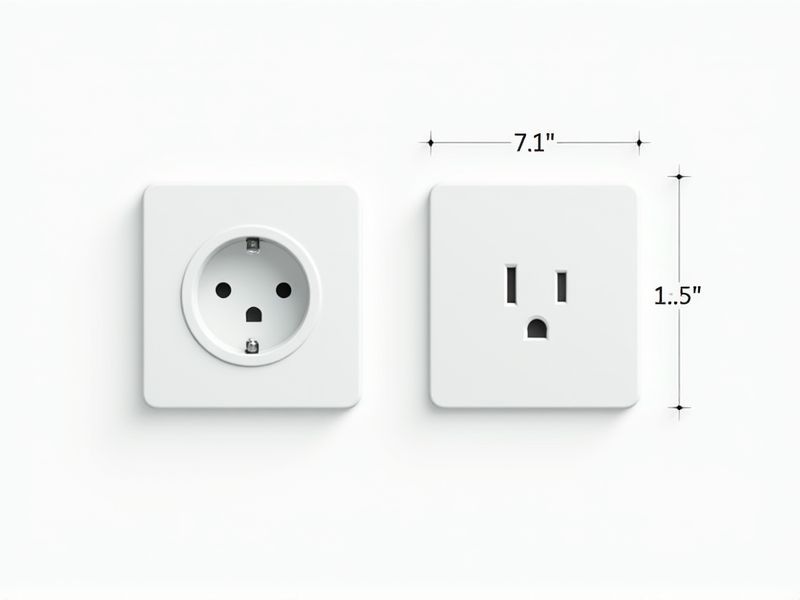
Standard power outlet dimensions can vary by country, but in the United States, the most common wall outlet plate measures about 4.5 inches high by 2.75 inches wide (11.4 cm x 7 cm). The actual electrical receptacle typically has an opening that fits standard plugs, with spacing for two vertical slots and a round ground pin slot below. When installing or replacing outlets, it's important to ensure the faceplates and electrical boxes fit these standard sizes for safety and compatibility. Always follow local electrical codes and consider consulting a qualified electrician for installation.
Voltage Rating
The standard voltage rating for power outlets typically ranges from 100 to 240 volts, depending on the country. In North America, most outlets deliver a voltage of 120 volts, while many European countries utilize a standard voltage of 230 volts. Ensuring your devices are compatible with these voltage ratings can significantly reduce the risk of electrical damage or inefficient operation. You should also verify the outlet type, as different regions utilize various plug configurations which may require an adapter for your devices.
Current Rating
The standard power outlet typically has a current rating of 15 to 20 amperes, which is essential for accommodating various electrical devices. Outlets designed for higher loads, such as those for kitchen appliances, often provide a current rating of 30 amperes. It's crucial to ensure that your electrical system supports these ratings to prevent overload and potential hazards. Always check the specifications of your devices to match them with appropriate outlets for optimal performance and safety.
Frequency Rating
The frequency rating of power outlets typically ranges from 50 Hz to 60 Hz, with most countries adopting one or the other as a standard. This specification is crucial for ensuring compatibility with electrical devices, as a mismatch can lead to malfunctions and reduced lifespan. For instance, Europe predominantly uses a frequency of 50 Hz, while North America adheres to 60 Hz, affecting how appliances perform in each region. Ensuring your devices match the frequency of your outlet will help maintain efficiency and safety in your electrical usage.
Plug Type Compatibility
Power outlet standards primarily hinge on plug type compatibility, with common configurations including Type A, B, C, D, and G among others. The Type A plug features two flat parallel pins and is widely used in North America, while Type C, known for its two round pins, is prevalent in Europe and South America. Understanding the voltage and frequency specifications is essential; for example, the standard voltage in the US is 120V at 60Hz, whereas many European countries utilize 230V at 50Hz. Ensuring your devices match these standards can prevent electrical damage and ensure safe operation when traveling or relocating.
Grounding Configuration
The grounding configuration of power outlets is crucial for electrical safety and efficient operation, with most residential outlets featuring a three-prong design that includes a ground wire. In the United States, the National Electrical Code (NEC) mandates that all new outlets in living spaces must have a proper grounding system, significantly reducing the risk of electric shock and fire hazards. Proper grounding can minimize electromagnetic interference, improving the performance of sensitive electronic devices. Ensure your outlets meet these standards to protect both your equipment and personal safety.
Outlet Box Size
The standard outlet box size for residential electrical installations typically measures 4 inches by 4 inches with a depth of 2.5 inches, accommodating various wiring setups. The National Electrical Code (NEC) mandates that outlet boxes provide ample space for connections, ensuring safety and functionality. For homes requiring additional outlets, a standard box can support up to 12 conductors, allowing circuit versatility. You should consider the box size carefully, as insufficient space can lead to overheating and electrical hazards.
Mounting Height
The ideal mounting height for power outlets is typically 15 to 48 inches above the finished floor, depending on their intended use and applicable building codes. For residential applications, a common height is around 18 inches, which provides easy access while ensuring safety from water exposure in areas like kitchens and bathrooms. In commercial settings, outlets should be mounted at 36 inches to accommodate various workstations and equipment needs. Ensure compliance with the National Electrical Code (NEC) for safe and effective outlet placement in your space.
Switch Integration
Power outlet standards are evolving to emphasize seamless switch integration, enhancing user experience and energy management. Current specifications advocate for smart switches that can control multiple outlets, allowing you to automate and monitor energy consumption in real-time. With energy-saving features, these integrated systems can reduce your electricity bill by up to 20% annually. Additionally, over 70% of households are projected to adopt such integrated power solutions by 2025, reflecting a significant shift toward modern, eco-friendly living environments.
Tamper-Resistant Feature
Tamper-resistant power outlets are designed to enhance safety by preventing accidental insertion of foreign objects, with built-in shutters that only allow the insertion of plugs. In the United States, the National Electrical Code (NEC) mandates that all new residential outlets installed after 2014 must be tamper-resistant, significantly reducing the risk of electrical shock, especially for children. These outlets typically offer a standard rating of 15 or 20 amperes, ensuring they can accommodate a wide range of devices while maintaining safety. By choosing tamper-resistant options for your home, you can minimize hazards and comply with modern electrical safety standards.
Weatherproofing Capabilities
Weatherproof power outlets are designed to withstand various environmental conditions, ensuring safety and durability with an IP rating of at least 44. These outlets often feature sealed covers that protect against moisture, dust, and temperature fluctuations, making them suitable for outdoor use. With an operating temperature range typically between -20degC and 50degC, they maintain functionality in extreme weather. When installing, ensure that the outlets are properly mounted and follow local electrical codes to maximize their weatherproofing capabilities.
